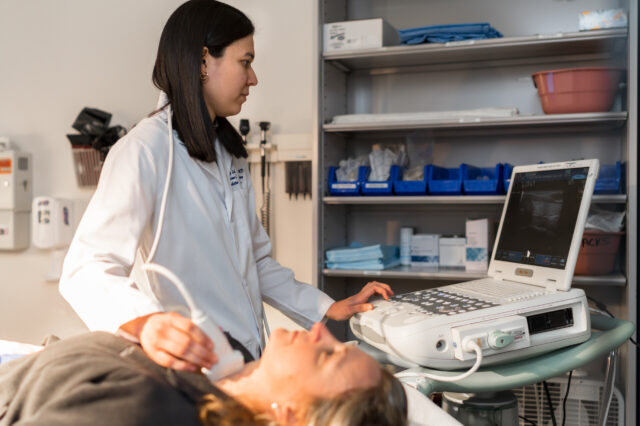UF Health study provides guidance to avoid unnecessary thyroid biopsies

The number of people diagnosed with thyroid cancer has more than quadrupled in the last 40 years, even as the disease’s death rate remained relatively unchanged.
It is a classic case of disease overdiagnosis, with little resulting benefit for many patients, said University of Florida Health endocrinologist Naykky Singh Ospina, M.D., an assistant professor in the UF College of Medicine’s division of endocrinology, diabetes and metabolism and a member of the UF Health Cancer Center.
Does it do more harm than good to investigate every thyroid nodule to the fullest?
In a paper recently published in The BMJ, Singh Ospina is the lead author of an analysis of the medical literature to give physicians a handy reference on strategies for the diagnosis, treatment and monitoring of thyroid nodules. Go to https://www.bmj.com/content/368/bmj.l6670.full to read the paper.
Why has the diagnosis of thyroid nodules increased?
Thyroid nodules are found very commonly in people who have no symptoms. They are often detected incidentally as doctors treat other ailments, either on imaging such as an ultrasound or CT scan, or during a physical exam. Imaging technology is more widely available than ever before, which is a good thing. But any imaging that includes the neck can detect a thyroid nodule, and these nodules are present in about 60% of the population. That incidental, indirect screening contributes to thyroid cancer being one of the most common cancer diagnoses. And that can lead to over-treatment.
What is the main thrust of your paper?
A large number of thyroid nodules being diagnosed are small and/or have a low risk of being cancerous. These nodules could be monitored without biopsy. If we were to biopsy all of them, we would be exposing patients to the harm of potential complications and the cost of excessive treatment. And we’d be doing it without resulting benefit for most patients, because, while thyroid cancer is diagnosed more and more frequently, mortality is relatively unchanged. Many of these small and low-risk thyroid cancers will pose no risk to patients if they were to remain undiagnosed and untreated.
This is not to say that thyroid cancer can be dismissed out of hand as insignificant?
No. You sometimes hear people say, “If I’m going to have one cancer, make it thyroid cancer.” I disagree completely. It’s important to understand the danger aggressive types of thyroid cancer can pose, including death. Additionally, certain types of thyroid cancer can cause a lot of morbidity and complications. The key is knowing which thyroid cancers are aggressive and require immediate diagnosis and treatment and which are less aggressive and might be monitored without surgery.
How important is the patient’s input in any treatment decision-making?
It’s critically important to have a discussion with the patient about the best approach given their situation, clinical presentation and their estimated risk of thyroid cancer. We hope physicians discuss the clinical evidence and collaborate with patients when making the decision on whether to do a biopsy or monitor with ultrasound. The goal is that this collaboration leads to decisions that make sense to the patients, too.
What do clinical guidelines tell us today about when to biopsy a thyroid nodule?
In general, guidelines recommend against biopsy for nodules less than 1 centimeter in size without lymph node involvement. For patients with thyroid nodules larger than 1 cm, different thresholds for thyroid biopsy are recommended, depending on the size and ultrasound appearance of a nodule and on whether the patient has personal risk factors for thyroid cancer. Those risk factors include a family history of thyroid cancer or neck exposure to ionizing radiation. Critically, physicians must also consider the patient’s preference.
Your paper indicates thyroid biopsies are not always able to definitely confirm cancer?
In up to 30% of cases, we have indeterminate biopsy results. The point we make in the paper is that we can use everything that is known to this point — the ultrasound features, the clinical features, the biopsy result, genetic testing — to come up with a new estimate of cancer risk so that we can decide what to do. Even with an inconclusive result, the risk for thyroid cancer can be more than 60% for some people. For most patients, that’s high enough to surgically remove the nodule. On the other hand, other patients can have a risk of thyroid cancer of 5% after an indeterminate result, and in that case close follow-up with ultrasound might be a more reasonable alternative.
About the author
